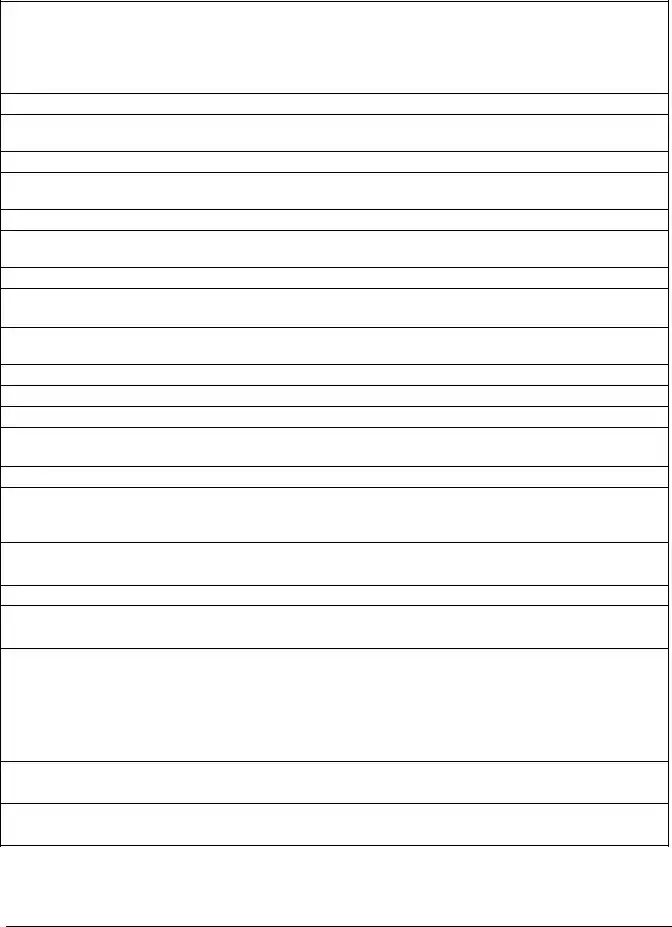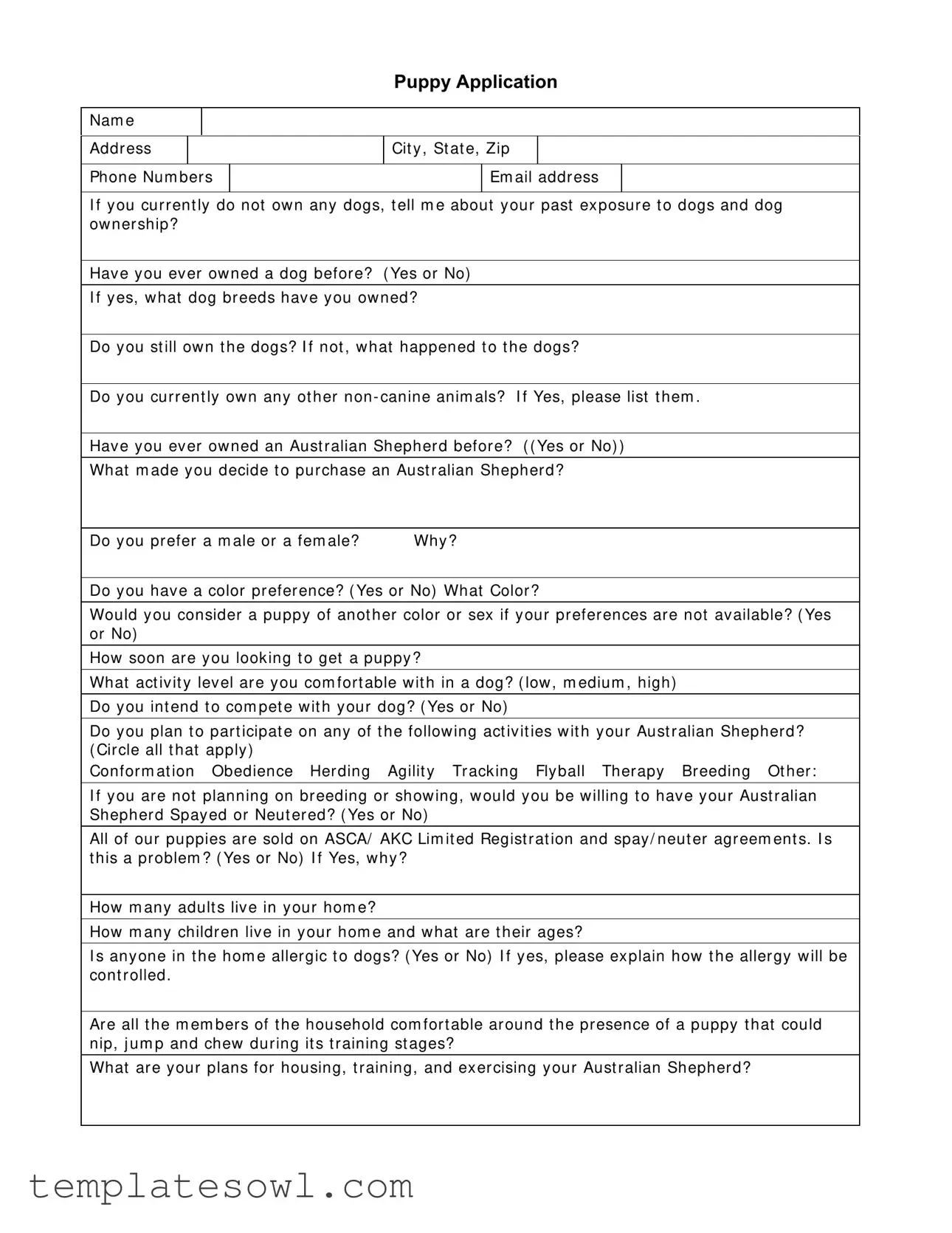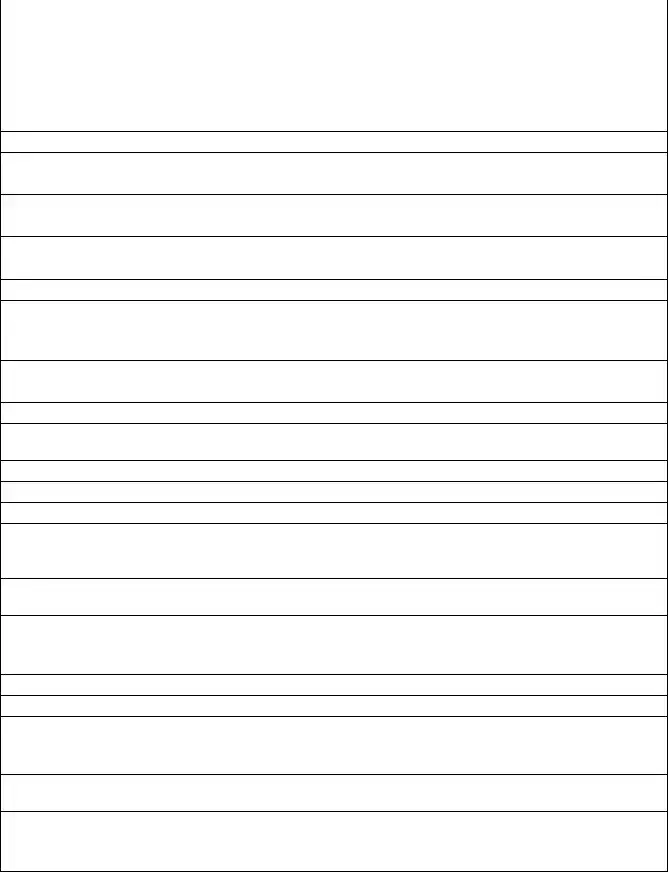|
|
|
|
Puppy Application |
|
|
|
|
|
|
|
|
Nam e |
|
|
|
|
|
|
|
|
|
|
|
|
|
|
Addr ess |
|
|
Cit y , St at e, Zip |
|
|
|
|
|
|
|
|
|
Phone Num ber s |
|
|
Em ail addr ess |
|
|
|
|
|
|
|
|
|
I f y ou cur r ent ly do not ow n any dogs, t ell m e about y our past ex posur e t o dogs and dog ow ner ship?
Hav e y ou ev er ow ned a dog before? ( Yes or No)
I f y es, w hat dog br eeds hav e y ou ow ned?
Do y ou st ill ow n t he dogs? I f not , w hat happened t o t he dogs?
Do y ou cur r ent ly ow n any ot her non - canine anim als? I f Yes, please list t hem .
Hav e y ou ev er ow ned an Aust r alian Shepher d befor e? ( ( Yes or No) )
What m ade y ou decide t o pur chase an Aust r alian Shepher d?
Do y ou pr efer a m ale or a fem ale? Why ?
Do y ou hav e a color pr efer ence? ( Yes or No) What Color ?
Would y ou consider a puppy of anot her color or sex if y our pr efer ences ar e not av ailable? ( Yes or No)
How soon ar e y ou look ing t o get a puppy ?
What act iv it y lev el ar e y ou com fort able w it h in a dog? ( low , m edium , high)
Do y ou int end t o com pet e w it h y our dog? ( Yes or No)
Do y ou plan t o par t icipat e on any of t he follow ing act iv it ies w it h y our Aust r alian Shepher d? ( Cir cle all t hat apply )
Confor m at ion Obedience Her ding Agilit y Tr ack ing Fly ball Therapy Br eeding Ot her :
I f y ou ar e not planning on br eeding or show ing, w ould y ou be w illing t o hav e y our Aust r alian Shepher d Spay ed or Neut er ed? ( Yes or No)
All of our puppies ar e sold on ASCA/ AKC Lim it ed Regist r at ion and spay / neut er agr eem ent s. I s t his a pr oblem ? ( Yes or No) I f Yes, w hy ?
How m any adult s liv e in y our hom e?
How m any childr en liv e in y our hom e and w hat ar e t heir ages?
I s any one in t he hom e aller gic t o dogs? ( Yes or No) I f y es, please ex plain how t he aller gy w ill be cont r olled.
Ar e all t he m em ber s of t he household com for t able ar ound t he pr esence of a puppy t hat could nip, j um p and chew dur ing it s t r aining st ages?
What ar e y our plans for housing, t r aining, and ex er cising y our Aust r alian Shepher d?

How do t he m em ber s of t he fam ily feel about cleaning fecal m at er ial fr om t he y ar d, possible holes being dug in t he landscaping, and pat hs being w or n fr om t he pat t er of paw s ar ound t he y ar d?
Ar e y ou com for t able w it h a br eed t hat sheds m oder at ely ? ( Yes or No)
On av er age, w hat do y ou plan t o spend per y ear on food, v et er inar y car e, and so for t h for y our Aust r alian Shepher d?
How m uch do y ou ex pect t o pay for an Aust ralian Shepher d puppy ?
Hav e y ou spok en w it h any ot her Aust r alian Shepher d br eeder s? ( Yes or No) I f Yes, please list t hem :
Ar e y ou curr ent ly on t he w ait ing list for any ot her lit t er s? ( Yes or No)
Ar e y ou int er est ed in being cont act ed about Rescue dogs or older dogs needing placem ent if w e should com e acr oss a dog t hat w e feel w ould suit y our needs? ( Yes or No)
Do y ou ow n or r ent y our hom e?
Ty pe of dw elling:
House Apar t m ent / Condo Mobile Hom e RV or Tr ailer
I f y ou ar e rent ing or liv e in a condo, do y ou hav e y our landlor d’s or condo associat ion’s per m ission t o k eep a dog? ( Yes or No)
Do y ou have a fenced y ar d? ( Yes or No)
I f y es, t ype of fence, w idt h, height :
I f no, w hat ar r angem ent s w ill y ou hav e for t he dogs t oilet dut ies:
Wher e w ill t his dog spend t he day ( Cir cle all t hat applies)
Loose indoor s Cr at e Basem ent Gar age Fenced Yar d Kennel Run Loose out door s Ot her :
How m any hour s on t he av er age w ill t he dog spend alone?
Wher e w ill dog spend t he night ( Cir cle all t hat applies)
Loose indoor s Tied up out side Crat e Basem ent Gar age Fenced Yar d Kennel Run Loose Out door s Ot her :
Hav e y ou ev er giv en up a dog t o a shelt er or pound? I f so, w hy ?
What t y pe of per sonalit y ar e y ou look ing for in y our dog?
Who w ill t ak e car e of y our puppy w hen y ou go on v acat ion?
Please list t w o r efer ences such as a Vet er inar ian, per son act iv e in dogs or close acquaint ance. I nclude a phone num ber and e- m ail addr ess if possible for each r eference.
I f y ou ar e est ablished w it h a v et , please pr ov ide nam e, addr ess and phone of v et .
How did y ou find out about t his breeding?
Puppy Applicat ion |
Nam e _______________________ |
Page 2 of 2 |


